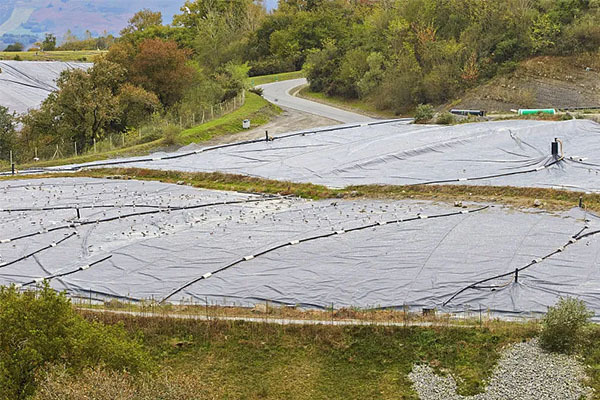Essential Features to Look for in a Geogrid Welding Machine: A Comprehensive Guide
Release time:
2025-06-22
Essential Features to Look for in a Geogrid Welding Machine Introduction In the ever-evolving world of construction and geotechnical engineering, **geogrid welding machines** have become indispensable tools for ensuring the structural integrity of various applications. Whether you're working with soil stabilization, retaining walls, or road construction, selecting the right welding machine can dra
Essential Features to Look for in a Geogrid Welding Machine
Introduction
In the ever-evolving world of construction and geotechnical engineering, **geogrid welding machines** have become indispensable tools for ensuring the structural integrity of various applications. Whether you're working with soil stabilization, retaining walls, or road construction, selecting the right welding machine can drastically influence the quality and durability of your projects. This guide explores the **essential features** to consider when investing in a geogrid welding machine.
1. Understanding Geogrids and Their Importance
Before diving into the features of geogrid welding machines, it’s pertinent to understand what geogrids are. **Geogrids** are polymeric materials used to reinforce soil and improve the load-bearing capacity of structures. They are widely utilized in construction projects, where they provide stability and durability, making welding crucial for ensuring their effectiveness.
1.1 Benefits of Geogrids
- **Enhanced Stability**: Geogrids distribute loads more evenly, preventing soil erosion and shifting.
- **Cost-Effectiveness**: They reduce the amount of material needed for construction, leading to lower costs.
- **Environmental Benefits**: Geogrids can minimize the ecological footprint of construction projects by reducing soil disturbance.
2. Key Features of Geogrid Welding Machines
2.1 Welding Technology
When selecting a geogrid welding machine, the **welding technology** used is a fundamental consideration. The most common technologies include hot air welding, ultrasonic welding, and resistance welding. Each method has its distinct advantages and is suited for different applications.
Hot Air Welding
This method uses heated air to join materials, making it ideal for thermoplastic geogrids. It offers a strong bond and is particularly effective in outdoor environments.
Ultrasonic Welding
This technology utilizes high-frequency sound waves to generate heat and bond materials. It is known for its speed and precision, making it a popular choice for smaller projects.
Resistance Welding
In this process, an electric current is passed through the materials to create heat at the joints. This technique is effective for thicker materials and provides strong seams.
2.2 Adjustable Temperature Control
A welding machine with **adjustable temperature control** allows users to set the optimal temperature for different materials. This is crucial for achieving the best welding results while preventing damage to the geogrid.
2.3 Welding Speed
The **welding speed** of the machine directly impacts productivity. Machines with adjustable speed settings enable users to adapt to various project requirements, ensuring efficient operation without compromising quality.
2.4 Portability and Design
Portability is another essential feature, especially for field work. A lightweight, compact design makes it easier to transport the welding machine to different sites. Additionally, ergonomic designs enhance user comfort and reduce fatigue during extended periods of operation.
2.5 Durability and Build Quality
Investing in a well-built machine ensures longevity and reliable performance. Look for machines constructed from high-quality materials that can withstand harsh working environments.
3. Operational Efficiency and User-Friendly Features
3.1 Control Interface
A user-friendly control interface is critical for effective operation. Look for machines that feature intuitive controls, digital displays, and easy-to-read indicators, allowing operators to monitor settings and make adjustments seamlessly.
3.2 Safety Features
Safety should be a priority when working with welding machines. Essential safety features to look for include:
- **Automatic shutoff**: This prevents overheating and potential accidents.
- **Overload protection**: This feature safeguards the machine from excessive current.
- **Emergency stop button**: Easily accessible buttons can halt operations instantly in emergencies.
4. Maintenance and Support
4.1 Ease of Maintenance
A machine that is easy to maintain ensures consistent performance over time. Features such as accessible components for cleaning and servicing can save time and reduce downtime.
4.2 Manufacturer Support and Warranty
Consider the level of support offered by the manufacturer. A robust warranty and responsive customer service can make a significant difference when issues arise. Research the reputation of the manufacturer in terms of product support and responsiveness.
5. Cost Considerations
5.1 Initial Investment vs. Long-Term Savings
While the initial cost of a geogrid welding machine may vary, consider the **long-term savings** associated with efficiency, durability, and maintenance costs. Investing in a high-quality machine may yield greater returns over time through enhanced productivity and reduced repair costs.
5.2 Budget-Friendly Options
For those on a tighter budget, there are mid-range options that still provide essential features without breaking the bank. Assess your specific needs and project requirements to find the best balance between cost and functionality.
6. Frequently Asked Questions (FAQs)
6.1 What materials can geogrid welding machines work with?
Geogrid welding machines typically work with various thermoplastic materials, including polypropylene, polyester, and polyethylene. The choice of material depends on the specific application and project requirements.
6.2 How do I determine the right welding technology for my project?
Choosing the right welding technology depends on factors such as material type, project size, and environmental conditions. Assess your specific needs and consult with manufacturers for recommendations.
6.3 What safety precautions should I take when operating a welding machine?
Always wear appropriate personal protective equipment (PPE), such as gloves and safety goggles. Ensure all safety features are functional and familiarize yourself with the machine's operation manual before use.
6.4 How often should a geogrid welding machine be serviced?
Regular maintenance is crucial for optimal performance. It's recommended to conduct inspections and servicing every few months or as specified in the manufacturer's guidelines.
6.5 Can I use a geogrid welding machine for other applications?
While geogrid welding machines are specialized, some can be adapted for other welding tasks involving similar materials. Always consult the manufacturer to confirm compatibility.
Conclusion
Selecting the right geogrid welding machine involves careful consideration of various features and specifications. By focusing on welding technology, operational efficiency, and user-friendly design, you can make an informed decision that enhances your productivity and project quality. Whether you're a seasoned professional or a newcomer in the industry, understanding these essential features will guide you in choosing a machine that meets your needs effectively. Investing in a high-quality geogrid welding machine not only enhances your work but also contributes to the overall success of your construction projects.
Previous Page






